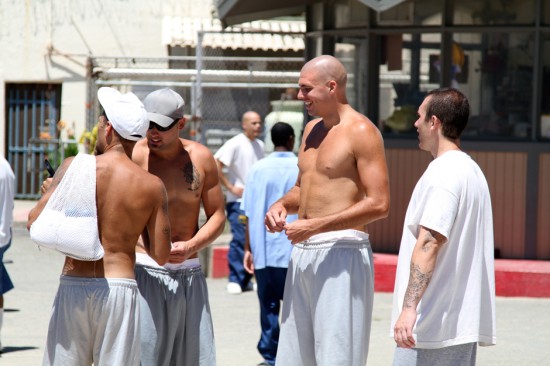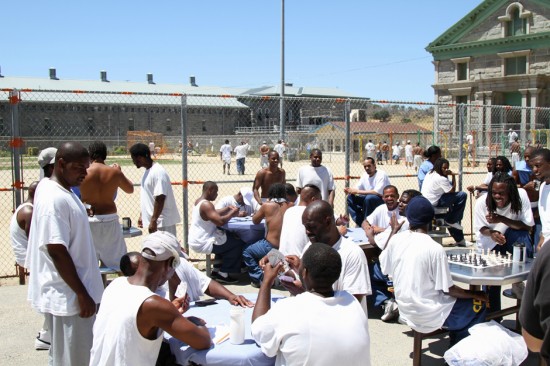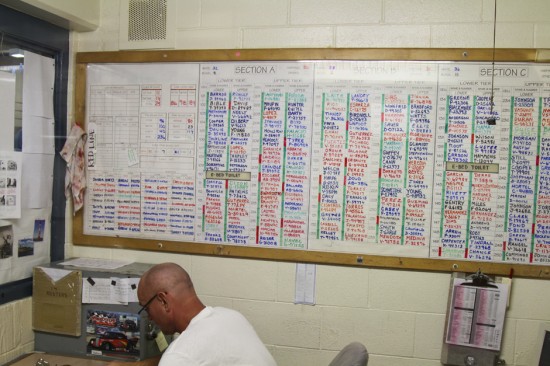Integrating California’s prison cells

Inmates in the “white” section of the yard at Folsom State Prison.
California’s sprawling prison system, the nation’s largest, retains deep racial divisions, maintained both by inmate hierarchies and de facto state policy, a two-month long survey by a News21 reporting team has found.
Five years ago the Supreme Court decreed that racial classification alone may not dictate cell assignments for new or newly-transferred inmates in California’s prisons, but today inmates are assigned cellmates mostly along racial lines.
The California Department of Corrections and Rehabilitation implemented an integrated housing program at Folsom State Prison in Sacramento County five months ago, but a snapshot of the historic outdoor yard yields no clue of any change in the racial climate.
“It looks like a normal situation, calm and peaceful,” said Steve Novikoff, a 22-year veteran corrections officer, while fixing a squinted gaze on the yard. “But at a moment’s notice we can have violence.”
Racial groups command slices of territory. Black inmates play chess and work out on a stand of iron bars. Whites hold a spot just a few steps away, where they exercise or mill about in clusters.
At opposite sides of the oval, Native Americans and northern and southern California Hispanics lay claim to their turf. The thud of handball and basketball courts pops above the din of voices.
“These boundaries have been determined by the inmate population,” said Folsom spokesman Lt. Anthony Gentile.
More than a dozen inmates in interviews said integrated housing, which began here in February, amounted to plenty of hype, but no change.
“The racial politics here won’t change,” said Ernie Santillan, 50, who is serving an eight-year sentence for drug sales. “The tiers (cell blocks) are already integrated, but the cells, no way.”
Gentile noted that tensions rose during an education period before the policy’s implementation, which included questionnaires, town hall meetings and interviews.
“Initially, it was very tense,” Gentile said, “A lot of the inmates believed that we are going to basically shuffle the deck and we were just going to start forcing these guys (together).”
Inmates generally agreed.
“In the short run, you would be dealing with a lot of lockdowns and a lot of hospital trips,” said a Native American inmate who would identify himself only by his last name, “Allen.”
Instead, the department adopted a cautious, go-slow approach that critics say falls short.
“Much goes on behind our prison walls that is not consistent with the Constitution,” said Donald Specter, chief counsel at the Bay Area-based Prison Law Office. “There should not be continuing racial segregation by the government in any area of our society, including prison.”
The state opposed the lawsuit, which was brought by Garrison Johnson, a black inmate who alleged that segregating reception center cells violated his right to equal protection under the 14th Amendment.
Today, CDCR officials say they agree in principle with the court decision, the result of which has been the “Integrated Housing Program.”
“We began implementing integrated housing in 2008, and our intention has been to roll out gradually,” said CDCR spokeswoman Terry Thornton, in Sacramento.
But the process has been anything but swift. The policy has been implemented in four of the state’s 30 male facilities.
CDCR is unable to provide data about the percentage of racially-integrated cells.
“We are not tracking (racially integrated cells), that’s not how we are going to measure success,” Thornton said, adding that each inmate has been assigned an “integrated housing code” based on several factors, such as offense, behavior and associations.
Visits to Folsom and the prison in Mule Creek in Amador County provided accounts from inmates and staff who say that little has changed.
To critics, abolishing an antiquated system of racial sorting has been too long in coming, and too slow in achieving.
“It’s not a simple problem, but progress could be faster,” said Barry Krisberg, a senior fellow at the UC Berkeley Center for Criminal Justice. “How can we continue to condone overt segregation in any (state-supported) accommodations?”
The Texas comparison
In the early 1970s, the Texas prison system still resembled something out of the Antebellum South. Work crews, dining halls, cells and other accommodations were segregated based on skin color.
But the system changed when challenged by Allen Lamar, a career criminal who filed suit in 1972 against the Texas Department of Criminal Justice (TDCJ). He alleged systemic segregation deprived inmates of rights guaranteed by the Civil Rights Act of 1964.
The case was decided in Lamar’s favor five years later, in 1977. But it wasn’t until 1991 that the prison system began forcibly integrating cells.
“When the rubber meets the road, the question is whether you have buy-in across the structure,” said James Marquart, co-author of “First Available Cell,” a book on Texas’ integration. “Everyone within the system has to be on board. There has to be buy-in from all the interests. In Texas, it took over 20 years to get done.”
In California, where inmates are not forced to integrate, broad support appears to be lacking, according to many inmates and staff.
“The CDCR won’t talk to us,” said Ryan Sherman, a spokesman for the California Correctional Peace Officers Association (CCPOA), the union representing prison staff. “We have no say as to how this process should be implemented.”
Also important, Marquart said, Texas’ abolishing of segregation coincided with growth in prison capacity. The state added about 60 institutions in the 1980s and 1990s. With space to separate racial agitators, other inmates could integrate without fear of reprisal.
In California, overcrowded conditions present another obstacle. In Texas, about 160,000 inmates are distributed throughout more than 120 facilities. Most of California’s 33 prisons are already well-beyond capacity.
“If you’re not going to build, it’s not going to get done,” Marquart said.
Inmates and staff at Mule Creek and Folsom expressed fear that forced integration would trigger bloodshed, sentiments that were widespread in pre-integration Texas.
But during the first seven years after cell integration, violent assaults reported among integrated cellmates were lower than non-integrated, according to TDCJ statistics.
From 1990 through 1999 there were a total of 35,579 violent incidents. Out of those, 1,691, or 4.7 percent, were racially-motivated. Of those, 1,358 (3.8 percent) were among inmates who were not racially-integrated.
Less than one percent of the nearly 36,000 incidents recorded during the period were between integrated cell partners, according to TDCJ.

The numbers don’t surprise Michael Parks, 46, an African American inmate at Folsom. Parks first did time in Texas prisons.
“(In Texas) you don’t have a say so who your celly is,” said Parks, who is serving a life sentence for 2nd degree murder. “You move into a cell, and whatever race the guy is, you learn to live with him.”
At Folsom, Parks said he has been housed only with blacks.
In Texas, the TDCJ reports that 62 percent of its double-occupancy cells are now integrated.
“Integrating prisons has tended to have the same sort of effect as integrating schools,” said Robert Perkinson, a University of Hawaii professor and author of “Texas Tough,” a history of that state’s prison system. “After initial fears, violence instead is reduced, people get along better, racial lines dissipate.”
An unwritten legacy
Garrison Johnson is a notorious name in California corrections.
Johnson, an African American inmate in state prisons since 1987, filed the lawsuit that ultimately drew the Supreme Court’s attention to segregated cells.
During inter-institutional transfers over the years, Johnson shared cells only with other black inmates.
In his 1995 lawsuit, Johnson argued that race-based housing “…effectively erected whites only, blacks only, Hispanics only signs over the portals of the California prison system.”

After winding through lower courts, the U.S. Supreme Court ruled in 2005 that even temporarily segregating inmates by race is constitutionally suspect and should be subject to tight judicial scrutiny.
The court, in a 5-3 decision, reasoned that in the absence of a justification that is “narrowly tailored” – such as achieving prison safety when other methods are insufficient – housing based solely on race is legally indefensible.
Justice Clarence Thomas, the only black justice, was joined by Antonin Scalia and John Paul Stevens in dissent, although Stevens’ dissent argued that segregation is always unconstitutional.
Thomas and Scalia argued that the court should not interfere with prison officials on matters of race.
“The Constitution has always demanded less within the prison walls,” Thomas reasoned.
Segregation in cells in California had its beginnings in the 1960s and 1970s, experts say, when a combination of prison population growth, slashed rehabilitative programs and increasingly race-based prison gangs persuaded administrators to accept de facto segregation in double-celling. This practice was never formally proclaimed.
“You would get a group of inmates, just off the bus, all the paperwork not caught up, and there were decisions to make, sometimes based on race,” Thornton said. “It was just a desire to keep people from killing each other. It was never a policy, never written down, but it was done, we’re not going to deny that.”
Asked if the segregation of cells helped fuel the rise of racial hostility, Thornton said she did not know, but CDCR is “hopeful in-cell integration will assist in gang management, reduce racial tension and violence and reflect community values.”
Some inmates and critics were adamant that racial animosities have been deepened by corrections policy, and demand more forceful action.
“Going into prison in California has, for decades, meant getting inculcated with an extremely racist mentality,” said Krisberg, the senior fellow in criminal justice.
Will California cells be integrated?
CDCR hopes to begin integrating housing at two more prisons this year – the Correctional Training Facility in Soledad and Avenal State Prison – and three more in 2011.
Not all of the approximately 165,000 state prison inmates would be eligible. Many live in dormitories.
Others, such as Pelican Bay inmates, are judged to be so dangerous that they are housed alone.
Thornton says the CDCR has no statistics on roommate assignments because it does not “track the number of single- or double-celled inmates or how many are in dorms.”
Nevertheless, achieving race-blind integration would probably require reassigning thousands of inmates. More than half of surveyed inmates system-wide were found to be eligible for integrated cells, according to department statistics.
“The state has no budget, so there is no money for traveling and training of staff,” Thornton said, adding that CDCR cannot quantify the costs of the program.
“It’s like asking how much it costs to fingerprint (inmates),” she said.
At the same time, CDCR officials have sought to curb expectations.
“It’s unrealistic to think that all cells are going to be integrated,” Thornton said. Unlike Texas, CDCR does not keep records on how many cells are racially mixed.
On the positive side, the go-slow approach has kept the lid on a volatile situation.
Not a single incident of racial violence attributed to housing integration has been reported, Thornton said, although there was a brief, nonviolent protest at Sierra Conservation Center in 2008, and violent eruptions at Folsom and Chino Institution for Men last year.
But concerns linger. In a letter addressed to CDCR’s Secretary Matthew Cate, the Prison Law Office in mid-July urged the department to take immediate action to stop discrimination based on race.
According to the letter, California’s men’s facilities consistently conduct prison lockdowns based on individuals within racial groups, even if the incident that triggered it involved only a small number of inmates of that raced, amounting to a “disturbing policy and practice of racial discrimination within the prison system in violation of the Equal Protection Clause”.
Prison officials said the PLO is using an expanded definition of the term “lockdown,” making basic security measures seem more severe and disruptive than they are.
Thornton stressed that occasional, “modified” security lockdowns on certain populations are “operational necessities” to maintain safety behind the prison walls.
“We are going to review the claims made by the Prison Law Office,” Thornton said, adding, “We have policies in place to prohibit the use of race based lockdown targeting a specific racial or ethnic group unless there is a legitimate interest in doing so.”
Thornton said the department could not say whether the modified lockdowns were used with greater, declining or similar frequency compared to past years.
At Folsom, several inmates alleged that staff spread misinformation about integrated housing to stir unrest.
Lt. Gentile acknowledge that swirling rumors fanned tensions leading up to the disturbance – which inmates described as a “riot” – but denied that staff deliberately planted them.
“There was confusion among a lot of staff and inmates as well, a lot anxiousness,” Gentile said. “There was some bad choice of wording and bad interpretations.”

At Mule Creek, the reality is a mix of progress and persistent division.
Mule Creek is a “special needs” facility, where many inmates are overt homosexuals or targets for violent reprisals from members of their own racial group.
The dry-erase board on the wall of one housing wing lists 100 cells. The colors that corrections officers use to identify race indicate that 31 were racially-integrated.
That sample ratio is half of the integration rate reported for the Texas prison system as a whole.
Mule Creek announced double-cell integration as policy 2008.
Out of earshot of prison officials, several inmates at Mule Creek said the housing integration initiative was ineffective.
“If you take homosexuals out of it, probably like two percent of cells are black and white,” said inmate Frank Baldizan, 30. “Me? I cell with my own race.”